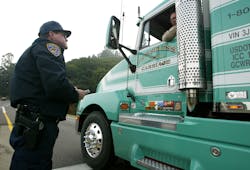Starting today, the “soft enforcement” period for the electronic logging device (ELD) mandate begins, as roadside enforcement personnel throughout the U.S. start documenting violations of the rule, according to the Commercial Vehicle Safety Administration (CVSA)
“At a jurisdiction’s discretion, they may issue citations to commercial motor vehicle drivers operating vehicles without a compliant ELD,” noted CVSA Executive Director Collin Mooney in a statement.
"Enforcement personnel have been trained in anticipation of the ELD rule, and now that it is in effect, inspectors will be verifying hours-of-service compliance by reviewing records of duty status requirements electronically,” he added. “And on April 1, 2018, inspectors will start placing commercial motor vehicle drivers out of service if their vehicle is not equipped with the required ELD.”
[More information regarding enforcement of the new rule is available at the Federal Motor Carrier Safety Administration’s ELD implementation website]
CVSA also pointed out that fleets and drivers may continue using “grandfathered” automatic onboard recording devices (AOBRD) that meet the requirements of 49 CFR 395.15 until Dec. 16, 2019, which is when they, too, must switch over the ELDs.
As the mandate goes into effect, many truckers – especially independents – are calling in essence for a strike; for truckers to park their tractor-trailers and not haul freight. Others, however, have gone ahead and installed ELDs with mixed reactions on how using them impacts how they operate.
“I refuse to drive a vehicle – especially a semi – with one [an ELD] in it. They're not safe for the driver behind the wheel or the public sharing the road,” Charles Claburn, a longtime driver and trucking activist based in Diberville, MS, who helps lead the 19,000-member anti-ELD group “ELD or Me,” stressed in a Facebook post.
“Trucking as many drivers grew up knowing it has changed, taking the use of common sense and throwing it out the window, and replacing it with a little black box that is supposed to make a driver safer,” he explained.
“For my fellow drivers – including company, local, port works, dock to dock, union, and long haul – every single one of you should be fighting this mandate,” Claburn said. “Being a driver is a brother hood, and when one part of the industry takes a hit from over regulation, every driver should stand and fight with them. It won't be long when they try to come after you.”
Other drivers responded to Claburn by noting that they are either parking their tractor-trailers for the time being and not hauling fright or quitting the industry altogether.
“Forty-two years of driving and I am done,” said driver Don Smith.
“I’m shut down here and I’m not moving,” added another driver, Bobby Joe Gibbs. “If I do move I’m going home and I’m done.”
A different set of truckers pointed out that, while they decided to comply with the regulations and install ELDs in their trucks, the use of said devices is forcing them to change how they operate.
“A lot of guys are worried about time management when switching over to ELDs; they think it will be a huge issue. But I’ve been using an ELD plugged into my truck for six weeks for now. It seems pretty easy, though it’s like going from a flip phone to iPhone – there’s a bit of a learning curve,” Chad Boblett, an owner-operator out of Kentucky, explained to American Trucker.
“The biggest thing, though, is I’ve lost flexibility. I’m up against the clock and every minute counts – I don’t know what might slow me down along the way that could cause problems,” he added. “The biggest thing I’ve noticed is that I drive a whole lot faster and I used to. I used to set cruise control for a stead speed, around 62 to 65 mph, and let the traffic pass me by. But now if the speed limit for trucks is 70 mph, I drive 70 mph.”
Trucking fleet managers like Lori Robb are also worried about the time constraints ELDs impose.
“When trucks don't come until the day after they were scheduled because they ran out of hours a half an hour away from where they are picking up a load, freight doesn't move to make room for the next day's loads to be staged,: she explained via Facebook. “Loads are late, customers re unhappy, and production has to slow down due to lack of space. That is the reality. I see it being a huge problem for all involved.”
Yet Lance Wood, a driver out of Missouri and president of Trucker Charity Inc., said from his perspective using an ELD is not changing his work day all that much.
“I ran 613.7 miles today [Dec. 16th] not speeding at all and running under the speed limit as my truck is governed at 65 mph,” he said via Facebook. “I did four deliveries and drop and hooked to eight different trailers, pre- and post-tripping each.”
At 1:45 pm, he took 47 minutes off-duty to get a haircut, do some grocery shopping, and eat lunch, and then at 4:20 pm following a last drop and hook he enjoyed in his words “a very nice catered sit down roast beef dinner.”
Overall, in Wood’s words, he had “a very nice and relaxing” day. “I was not rushed [and] still had 43 mins of drive time and time on my 14 [hour on-duty clock] left. Heck, yesterday, I waited over three hours at a stop and still did 530 miles,” he explained. “I guess I just am missing how this is going to really affect anything. Log it as you do it; exactly the same electronically as on paper.”
